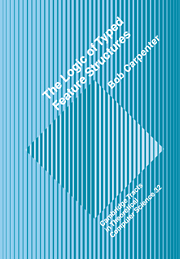 The Logic of Typed Feature Structures
The Logic of Typed Feature Structures Book contents
5 - Acyclic Feature Structures
Published online by Cambridge University Press: 12 October 2009
Summary
In this chapter we consider acyclic feature structures and their axiomatization. In standard first-order logic resolution theorem provers (see Wos et al. 1984 for an overview), it is necessary to make sure that when a variable X is unified with a term t, there is no occurrence of X in t. This is the so-called occurs check and dates back to Robinson's (1965) original algorithm for unification. Without the occurs check, resolution produces unsound inferences. The problem with the occurs check is that it is often expensive to compute in practical unification algorithms. Unification algorithms have been developed with built in occurs checks that are linear (Paterson and Wegman 1978) and quasi-linear (Martelli and Montanari 1982), but the data structures employed for computing the occurs check incur a heavy constant overhead (Jaffar 1984). Rather than carry out the occurs check, implementations of logic programming languages like Prolog simply omit it, leading to interpreters and compilers which are not sound with respect to the semantics of first-order logic and may furthermore cause the interpreters to hang during the processing of cyclic structures which are accidentally created. Rather than change the interpreters, the move made in Prolog II (Colmerauer 1984, 1987) was to change the semantics to allow for infinite rational trees, which correspond to the infinite unfoldings of the terms that result from unifications of a variable with a term that contains it. Considering the pointer-based implementation of unification (Jaffar 1984, Moshier 1988), infinite trees are more naturally construed as finite graphs containing cycles.
- Type
- Chapter
- Information
- The Logic of Typed Feature StructuresWith Applications to Unification Grammars, Logic Programs and Constraint Resolution, pp. 73 - 76Publisher: Cambridge University PressPrint publication year: 1992
